Strategic Infrastructure Asset Management: A Comprehensive Report
VerifiedAdded on 2021/04/21
|15
|4520
|131
Report
AI Summary
This report delves into the realm of strategic asset management, providing a comprehensive overview of its core principles, frameworks, and models. It begins with an introduction to the Asset Management Body of Knowledge (AMBoK), emphasizing its significance in guiding organizations toward effective asset management practices. The report then reviews relevant literature, highlighting key concepts such as asset management principles, strategic asset management models, and the importance of adopting a strategic approach to optimize asset performance. A significant portion of the report is dedicated to the strategic infrastructure asset management framework, discussing its importance and the evolution of asset management practices. The report also presents a framework of AMBoK and strategic asset management plans, including strategic analysis, strategic choice, and strategic implementation. The report underscores the necessity for organizations to align their asset management strategies with the ISO 55000 standards and consider the entire lifecycle of infrastructure assets. Overall, the report provides valuable insights into the practices and approaches essential for successful strategic asset management, emphasizing the need for proactive and cost-efficient strategies to achieve organizational goals.

Running Head: Strategic Asset Management
1
1
Paraphrase This Document
Need a fresh take? Get an instant paraphrase of this document with our AI Paraphraser
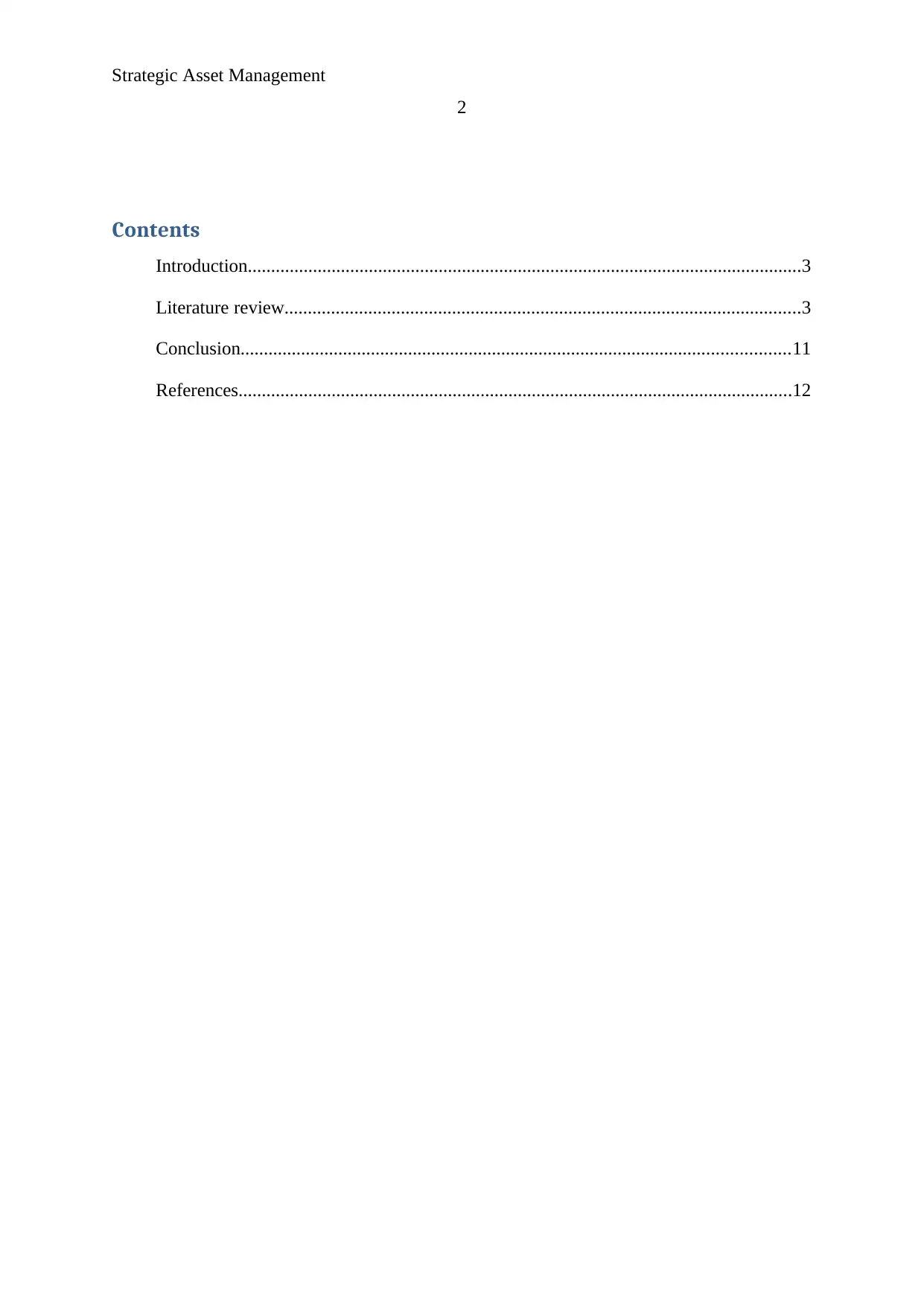
Strategic Asset Management
2
Contents
Introduction.......................................................................................................................3
Literature review...............................................................................................................3
Conclusion......................................................................................................................11
References.......................................................................................................................12
2
Contents
Introduction.......................................................................................................................3
Literature review...............................................................................................................3
Conclusion......................................................................................................................11
References.......................................................................................................................12
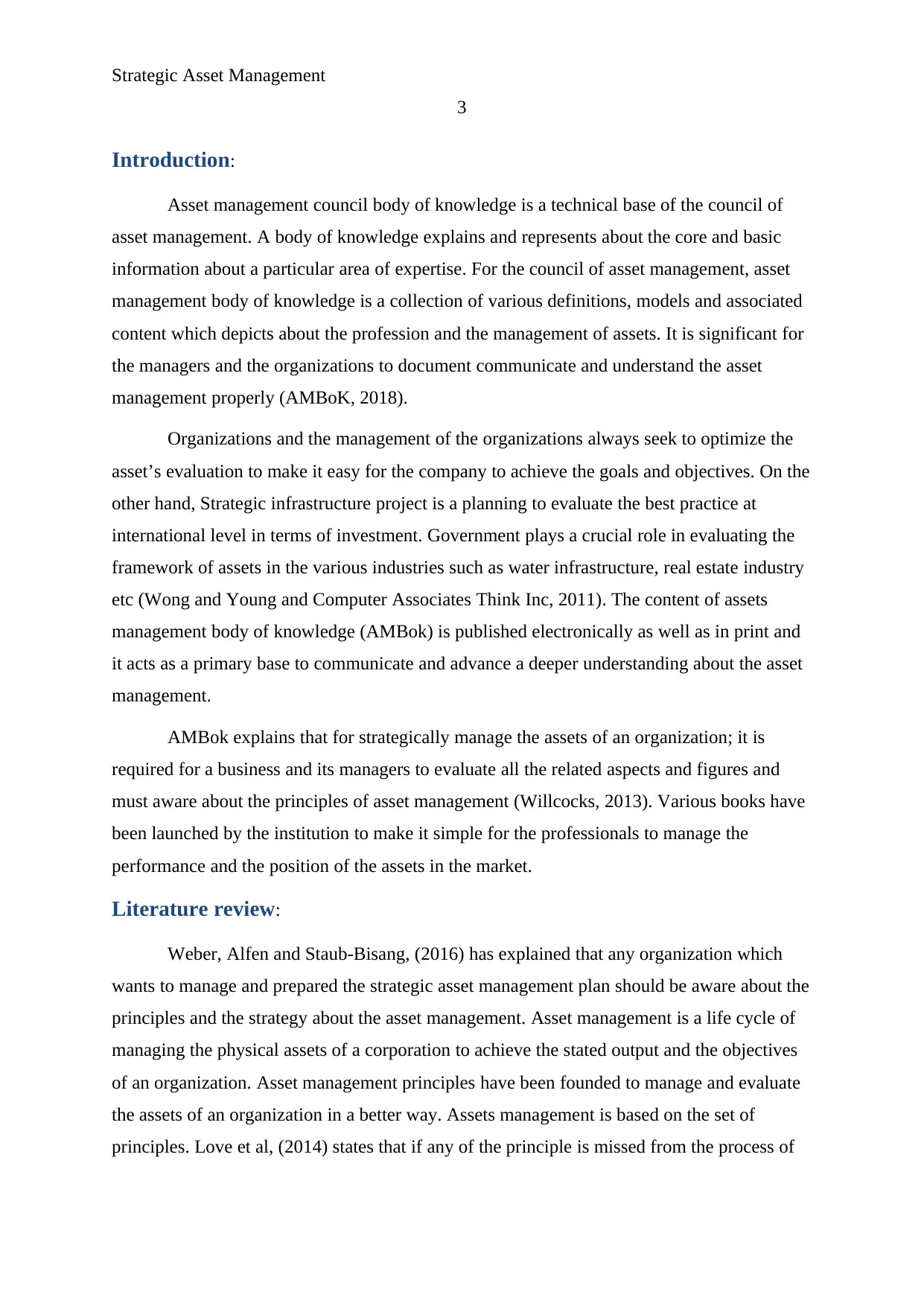
Strategic Asset Management
3
Introduction:
Asset management council body of knowledge is a technical base of the council of
asset management. A body of knowledge explains and represents about the core and basic
information about a particular area of expertise. For the council of asset management, asset
management body of knowledge is a collection of various definitions, models and associated
content which depicts about the profession and the management of assets. It is significant for
the managers and the organizations to document communicate and understand the asset
management properly (AMBoK, 2018).
Organizations and the management of the organizations always seek to optimize the
asset’s evaluation to make it easy for the company to achieve the goals and objectives. On the
other hand, Strategic infrastructure project is a planning to evaluate the best practice at
international level in terms of investment. Government plays a crucial role in evaluating the
framework of assets in the various industries such as water infrastructure, real estate industry
etc (Wong and Young and Computer Associates Think Inc, 2011). The content of assets
management body of knowledge (AMBok) is published electronically as well as in print and
it acts as a primary base to communicate and advance a deeper understanding about the asset
management.
AMBok explains that for strategically manage the assets of an organization; it is
required for a business and its managers to evaluate all the related aspects and figures and
must aware about the principles of asset management (Willcocks, 2013). Various books have
been launched by the institution to make it simple for the professionals to manage the
performance and the position of the assets in the market.
Literature review:
Weber, Alfen and Staub-Bisang, (2016) has explained that any organization which
wants to manage and prepared the strategic asset management plan should be aware about the
principles and the strategy about the asset management. Asset management is a life cycle of
managing the physical assets of a corporation to achieve the stated output and the objectives
of an organization. Asset management principles have been founded to manage and evaluate
the assets of an organization in a better way. Assets management is based on the set of
principles. Love et al, (2014) states that if any of the principle is missed from the process of
3
Introduction:
Asset management council body of knowledge is a technical base of the council of
asset management. A body of knowledge explains and represents about the core and basic
information about a particular area of expertise. For the council of asset management, asset
management body of knowledge is a collection of various definitions, models and associated
content which depicts about the profession and the management of assets. It is significant for
the managers and the organizations to document communicate and understand the asset
management properly (AMBoK, 2018).
Organizations and the management of the organizations always seek to optimize the
asset’s evaluation to make it easy for the company to achieve the goals and objectives. On the
other hand, Strategic infrastructure project is a planning to evaluate the best practice at
international level in terms of investment. Government plays a crucial role in evaluating the
framework of assets in the various industries such as water infrastructure, real estate industry
etc (Wong and Young and Computer Associates Think Inc, 2011). The content of assets
management body of knowledge (AMBok) is published electronically as well as in print and
it acts as a primary base to communicate and advance a deeper understanding about the asset
management.
AMBok explains that for strategically manage the assets of an organization; it is
required for a business and its managers to evaluate all the related aspects and figures and
must aware about the principles of asset management (Willcocks, 2013). Various books have
been launched by the institution to make it simple for the professionals to manage the
performance and the position of the assets in the market.
Literature review:
Weber, Alfen and Staub-Bisang, (2016) has explained that any organization which
wants to manage and prepared the strategic asset management plan should be aware about the
principles and the strategy about the asset management. Asset management is a life cycle of
managing the physical assets of a corporation to achieve the stated output and the objectives
of an organization. Asset management principles have been founded to manage and evaluate
the assets of an organization in a better way. Assets management is based on the set of
principles. Love et al, (2014) states that if any of the principle is missed from the process of
⊘ This is a preview!⊘
Do you want full access?
Subscribe today to unlock all pages.

Trusted by 1+ million students worldwide
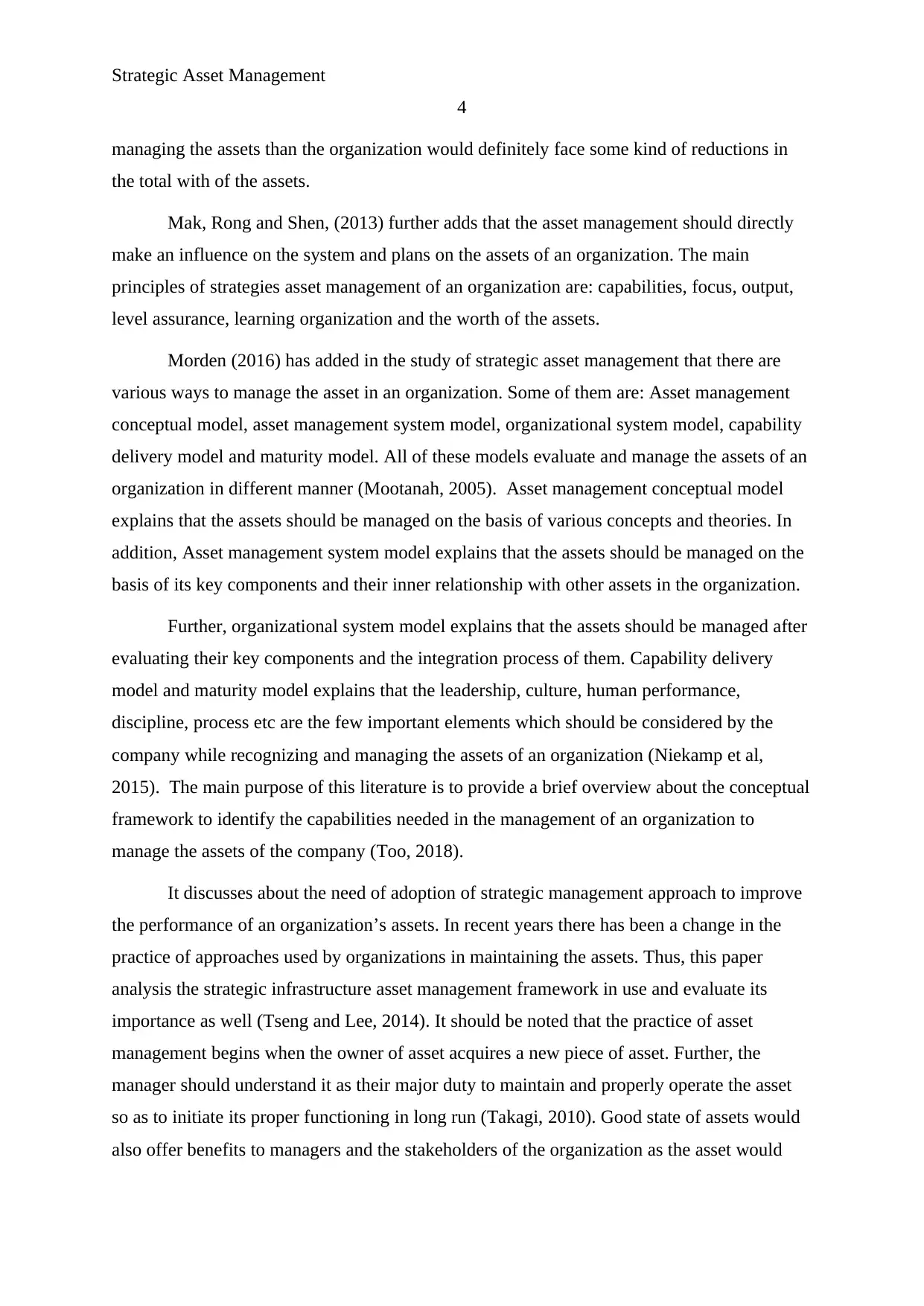
Strategic Asset Management
4
managing the assets than the organization would definitely face some kind of reductions in
the total with of the assets.
Mak, Rong and Shen, (2013) further adds that the asset management should directly
make an influence on the system and plans on the assets of an organization. The main
principles of strategies asset management of an organization are: capabilities, focus, output,
level assurance, learning organization and the worth of the assets.
Morden (2016) has added in the study of strategic asset management that there are
various ways to manage the asset in an organization. Some of them are: Asset management
conceptual model, asset management system model, organizational system model, capability
delivery model and maturity model. All of these models evaluate and manage the assets of an
organization in different manner (Mootanah, 2005). Asset management conceptual model
explains that the assets should be managed on the basis of various concepts and theories. In
addition, Asset management system model explains that the assets should be managed on the
basis of its key components and their inner relationship with other assets in the organization.
Further, organizational system model explains that the assets should be managed after
evaluating their key components and the integration process of them. Capability delivery
model and maturity model explains that the leadership, culture, human performance,
discipline, process etc are the few important elements which should be considered by the
company while recognizing and managing the assets of an organization (Niekamp et al,
2015). The main purpose of this literature is to provide a brief overview about the conceptual
framework to identify the capabilities needed in the management of an organization to
manage the assets of the company (Too, 2018).
It discusses about the need of adoption of strategic management approach to improve
the performance of an organization’s assets. In recent years there has been a change in the
practice of approaches used by organizations in maintaining the assets. Thus, this paper
analysis the strategic infrastructure asset management framework in use and evaluate its
importance as well (Tseng and Lee, 2014). It should be noted that the practice of asset
management begins when the owner of asset acquires a new piece of asset. Further, the
manager should understand it as their major duty to maintain and properly operate the asset
so as to initiate its proper functioning in long run (Takagi, 2010). Good state of assets would
also offer benefits to managers and the stakeholders of the organization as the asset would
4
managing the assets than the organization would definitely face some kind of reductions in
the total with of the assets.
Mak, Rong and Shen, (2013) further adds that the asset management should directly
make an influence on the system and plans on the assets of an organization. The main
principles of strategies asset management of an organization are: capabilities, focus, output,
level assurance, learning organization and the worth of the assets.
Morden (2016) has added in the study of strategic asset management that there are
various ways to manage the asset in an organization. Some of them are: Asset management
conceptual model, asset management system model, organizational system model, capability
delivery model and maturity model. All of these models evaluate and manage the assets of an
organization in different manner (Mootanah, 2005). Asset management conceptual model
explains that the assets should be managed on the basis of various concepts and theories. In
addition, Asset management system model explains that the assets should be managed on the
basis of its key components and their inner relationship with other assets in the organization.
Further, organizational system model explains that the assets should be managed after
evaluating their key components and the integration process of them. Capability delivery
model and maturity model explains that the leadership, culture, human performance,
discipline, process etc are the few important elements which should be considered by the
company while recognizing and managing the assets of an organization (Niekamp et al,
2015). The main purpose of this literature is to provide a brief overview about the conceptual
framework to identify the capabilities needed in the management of an organization to
manage the assets of the company (Too, 2018).
It discusses about the need of adoption of strategic management approach to improve
the performance of an organization’s assets. In recent years there has been a change in the
practice of approaches used by organizations in maintaining the assets. Thus, this paper
analysis the strategic infrastructure asset management framework in use and evaluate its
importance as well (Tseng and Lee, 2014). It should be noted that the practice of asset
management begins when the owner of asset acquires a new piece of asset. Further, the
manager should understand it as their major duty to maintain and properly operate the asset
so as to initiate its proper functioning in long run (Takagi, 2010). Good state of assets would
also offer benefits to managers and the stakeholders of the organization as the asset would
Paraphrase This Document
Need a fresh take? Get an instant paraphrase of this document with our AI Paraphraser
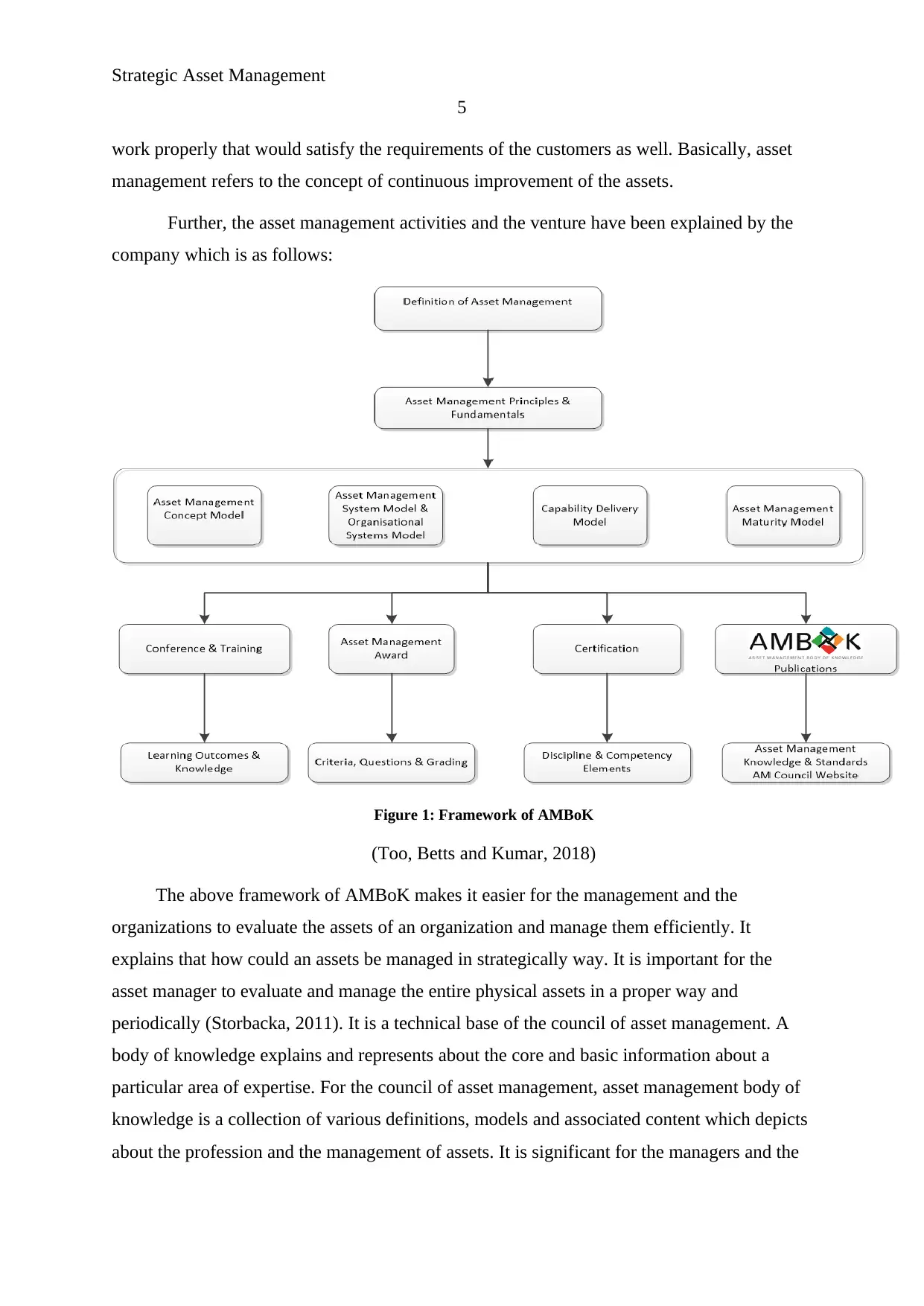
Strategic Asset Management
5
work properly that would satisfy the requirements of the customers as well. Basically, asset
management refers to the concept of continuous improvement of the assets.
Further, the asset management activities and the venture have been explained by the
company which is as follows:
Figure 1: Framework of AMBoK
(Too, Betts and Kumar, 2018)
The above framework of AMBoK makes it easier for the management and the
organizations to evaluate the assets of an organization and manage them efficiently. It
explains that how could an assets be managed in strategically way. It is important for the
asset manager to evaluate and manage the entire physical assets in a proper way and
periodically (Storbacka, 2011). It is a technical base of the council of asset management. A
body of knowledge explains and represents about the core and basic information about a
particular area of expertise. For the council of asset management, asset management body of
knowledge is a collection of various definitions, models and associated content which depicts
about the profession and the management of assets. It is significant for the managers and the
5
work properly that would satisfy the requirements of the customers as well. Basically, asset
management refers to the concept of continuous improvement of the assets.
Further, the asset management activities and the venture have been explained by the
company which is as follows:
Figure 1: Framework of AMBoK
(Too, Betts and Kumar, 2018)
The above framework of AMBoK makes it easier for the management and the
organizations to evaluate the assets of an organization and manage them efficiently. It
explains that how could an assets be managed in strategically way. It is important for the
asset manager to evaluate and manage the entire physical assets in a proper way and
periodically (Storbacka, 2011). It is a technical base of the council of asset management. A
body of knowledge explains and represents about the core and basic information about a
particular area of expertise. For the council of asset management, asset management body of
knowledge is a collection of various definitions, models and associated content which depicts
about the profession and the management of assets. It is significant for the managers and the
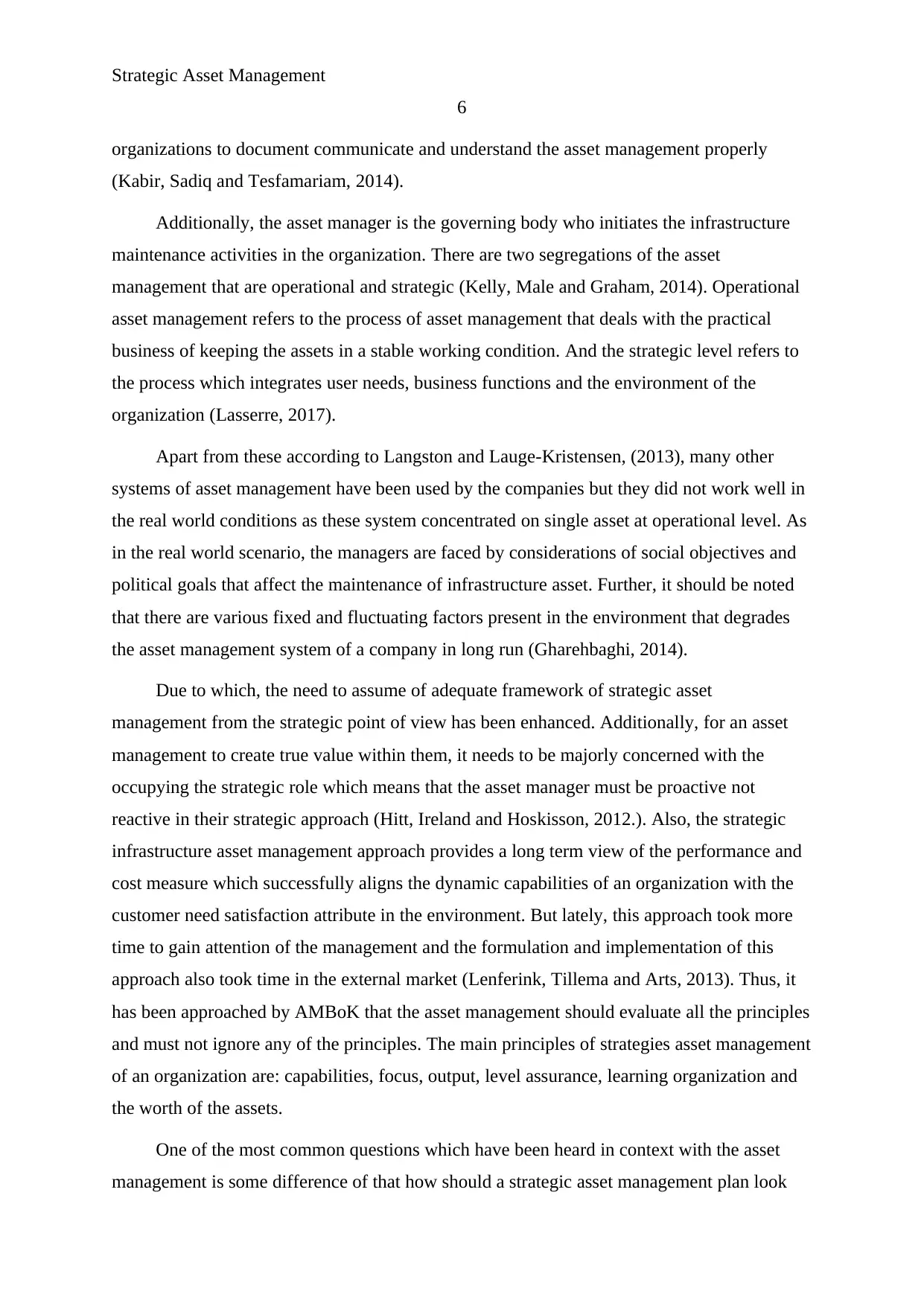
Strategic Asset Management
6
organizations to document communicate and understand the asset management properly
(Kabir, Sadiq and Tesfamariam, 2014).
Additionally, the asset manager is the governing body who initiates the infrastructure
maintenance activities in the organization. There are two segregations of the asset
management that are operational and strategic (Kelly, Male and Graham, 2014). Operational
asset management refers to the process of asset management that deals with the practical
business of keeping the assets in a stable working condition. And the strategic level refers to
the process which integrates user needs, business functions and the environment of the
organization (Lasserre, 2017).
Apart from these according to Langston and Lauge-Kristensen, (2013), many other
systems of asset management have been used by the companies but they did not work well in
the real world conditions as these system concentrated on single asset at operational level. As
in the real world scenario, the managers are faced by considerations of social objectives and
political goals that affect the maintenance of infrastructure asset. Further, it should be noted
that there are various fixed and fluctuating factors present in the environment that degrades
the asset management system of a company in long run (Gharehbaghi, 2014).
Due to which, the need to assume of adequate framework of strategic asset
management from the strategic point of view has been enhanced. Additionally, for an asset
management to create true value within them, it needs to be majorly concerned with the
occupying the strategic role which means that the asset manager must be proactive not
reactive in their strategic approach (Hitt, Ireland and Hoskisson, 2012.). Also, the strategic
infrastructure asset management approach provides a long term view of the performance and
cost measure which successfully aligns the dynamic capabilities of an organization with the
customer need satisfaction attribute in the environment. But lately, this approach took more
time to gain attention of the management and the formulation and implementation of this
approach also took time in the external market (Lenferink, Tillema and Arts, 2013). Thus, it
has been approached by AMBoK that the asset management should evaluate all the principles
and must not ignore any of the principles. The main principles of strategies asset management
of an organization are: capabilities, focus, output, level assurance, learning organization and
the worth of the assets.
One of the most common questions which have been heard in context with the asset
management is some difference of that how should a strategic asset management plan look
6
organizations to document communicate and understand the asset management properly
(Kabir, Sadiq and Tesfamariam, 2014).
Additionally, the asset manager is the governing body who initiates the infrastructure
maintenance activities in the organization. There are two segregations of the asset
management that are operational and strategic (Kelly, Male and Graham, 2014). Operational
asset management refers to the process of asset management that deals with the practical
business of keeping the assets in a stable working condition. And the strategic level refers to
the process which integrates user needs, business functions and the environment of the
organization (Lasserre, 2017).
Apart from these according to Langston and Lauge-Kristensen, (2013), many other
systems of asset management have been used by the companies but they did not work well in
the real world conditions as these system concentrated on single asset at operational level. As
in the real world scenario, the managers are faced by considerations of social objectives and
political goals that affect the maintenance of infrastructure asset. Further, it should be noted
that there are various fixed and fluctuating factors present in the environment that degrades
the asset management system of a company in long run (Gharehbaghi, 2014).
Due to which, the need to assume of adequate framework of strategic asset
management from the strategic point of view has been enhanced. Additionally, for an asset
management to create true value within them, it needs to be majorly concerned with the
occupying the strategic role which means that the asset manager must be proactive not
reactive in their strategic approach (Hitt, Ireland and Hoskisson, 2012.). Also, the strategic
infrastructure asset management approach provides a long term view of the performance and
cost measure which successfully aligns the dynamic capabilities of an organization with the
customer need satisfaction attribute in the environment. But lately, this approach took more
time to gain attention of the management and the formulation and implementation of this
approach also took time in the external market (Lenferink, Tillema and Arts, 2013). Thus, it
has been approached by AMBoK that the asset management should evaluate all the principles
and must not ignore any of the principles. The main principles of strategies asset management
of an organization are: capabilities, focus, output, level assurance, learning organization and
the worth of the assets.
One of the most common questions which have been heard in context with the asset
management is some difference of that how should a strategic asset management plan look
⊘ This is a preview!⊘
Do you want full access?
Subscribe today to unlock all pages.

Trusted by 1+ million students worldwide
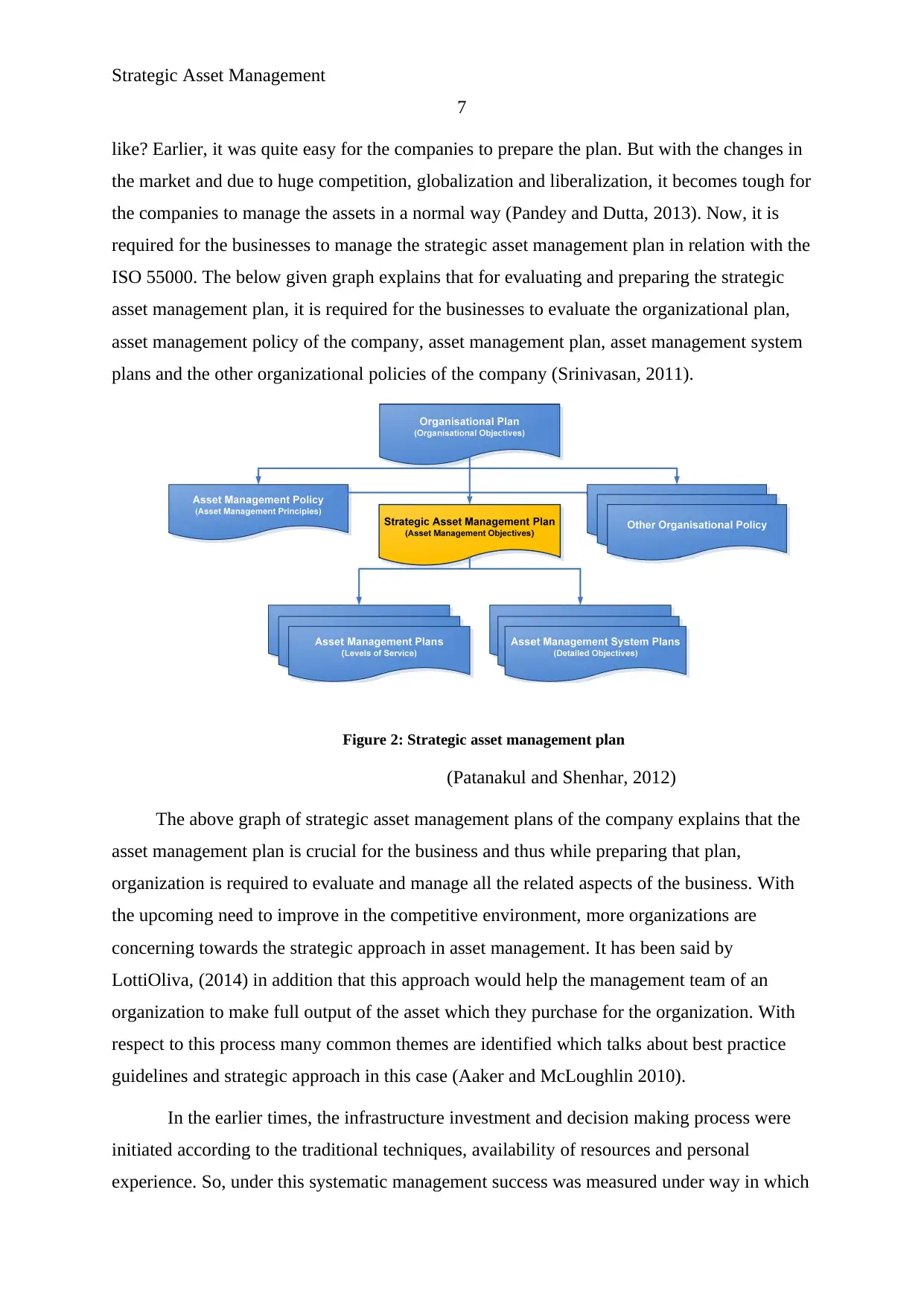
Strategic Asset Management
7
like? Earlier, it was quite easy for the companies to prepare the plan. But with the changes in
the market and due to huge competition, globalization and liberalization, it becomes tough for
the companies to manage the assets in a normal way (Pandey and Dutta, 2013). Now, it is
required for the businesses to manage the strategic asset management plan in relation with the
ISO 55000. The below given graph explains that for evaluating and preparing the strategic
asset management plan, it is required for the businesses to evaluate the organizational plan,
asset management policy of the company, asset management plan, asset management system
plans and the other organizational policies of the company (Srinivasan, 2011).
Figure 2: Strategic asset management plan
(Patanakul and Shenhar, 2012)
The above graph of strategic asset management plans of the company explains that the
asset management plan is crucial for the business and thus while preparing that plan,
organization is required to evaluate and manage all the related aspects of the business. With
the upcoming need to improve in the competitive environment, more organizations are
concerning towards the strategic approach in asset management. It has been said by
LottiOliva, (2014) in addition that this approach would help the management team of an
organization to make full output of the asset which they purchase for the organization. With
respect to this process many common themes are identified which talks about best practice
guidelines and strategic approach in this case (Aaker and McLoughlin 2010).
In the earlier times, the infrastructure investment and decision making process were
initiated according to the traditional techniques, availability of resources and personal
experience. So, under this systematic management success was measured under way in which
7
like? Earlier, it was quite easy for the companies to prepare the plan. But with the changes in
the market and due to huge competition, globalization and liberalization, it becomes tough for
the companies to manage the assets in a normal way (Pandey and Dutta, 2013). Now, it is
required for the businesses to manage the strategic asset management plan in relation with the
ISO 55000. The below given graph explains that for evaluating and preparing the strategic
asset management plan, it is required for the businesses to evaluate the organizational plan,
asset management policy of the company, asset management plan, asset management system
plans and the other organizational policies of the company (Srinivasan, 2011).
Figure 2: Strategic asset management plan
(Patanakul and Shenhar, 2012)
The above graph of strategic asset management plans of the company explains that the
asset management plan is crucial for the business and thus while preparing that plan,
organization is required to evaluate and manage all the related aspects of the business. With
the upcoming need to improve in the competitive environment, more organizations are
concerning towards the strategic approach in asset management. It has been said by
LottiOliva, (2014) in addition that this approach would help the management team of an
organization to make full output of the asset which they purchase for the organization. With
respect to this process many common themes are identified which talks about best practice
guidelines and strategic approach in this case (Aaker and McLoughlin 2010).
In the earlier times, the infrastructure investment and decision making process were
initiated according to the traditional techniques, availability of resources and personal
experience. So, under this systematic management success was measured under way in which
Paraphrase This Document
Need a fresh take? Get an instant paraphrase of this document with our AI Paraphraser
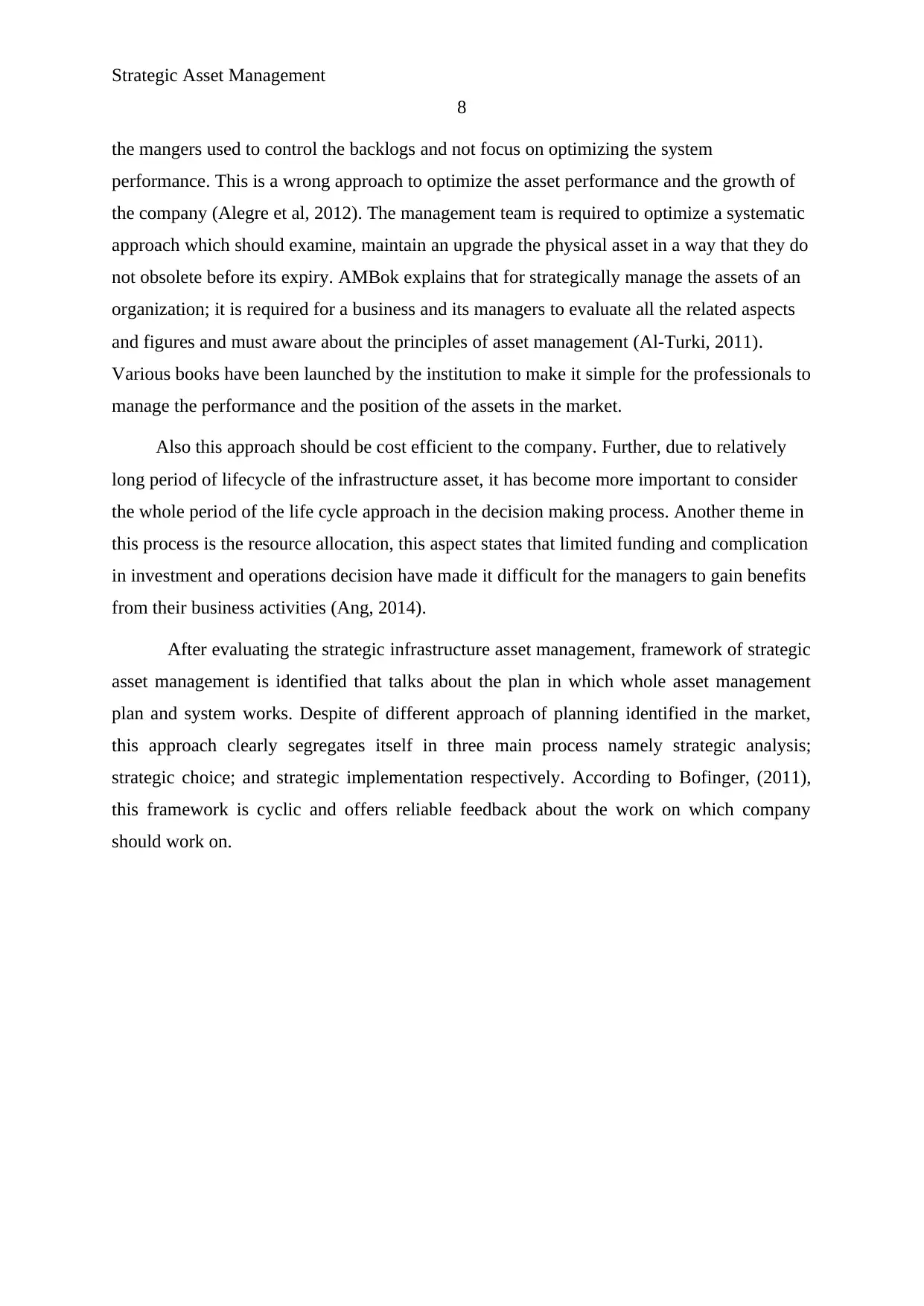
Strategic Asset Management
8
the mangers used to control the backlogs and not focus on optimizing the system
performance. This is a wrong approach to optimize the asset performance and the growth of
the company (Alegre et al, 2012). The management team is required to optimize a systematic
approach which should examine, maintain an upgrade the physical asset in a way that they do
not obsolete before its expiry. AMBok explains that for strategically manage the assets of an
organization; it is required for a business and its managers to evaluate all the related aspects
and figures and must aware about the principles of asset management (Al-Turki, 2011).
Various books have been launched by the institution to make it simple for the professionals to
manage the performance and the position of the assets in the market.
Also this approach should be cost efficient to the company. Further, due to relatively
long period of lifecycle of the infrastructure asset, it has become more important to consider
the whole period of the life cycle approach in the decision making process. Another theme in
this process is the resource allocation, this aspect states that limited funding and complication
in investment and operations decision have made it difficult for the managers to gain benefits
from their business activities (Ang, 2014).
After evaluating the strategic infrastructure asset management, framework of strategic
asset management is identified that talks about the plan in which whole asset management
plan and system works. Despite of different approach of planning identified in the market,
this approach clearly segregates itself in three main process namely strategic analysis;
strategic choice; and strategic implementation respectively. According to Bofinger, (2011),
this framework is cyclic and offers reliable feedback about the work on which company
should work on.
8
the mangers used to control the backlogs and not focus on optimizing the system
performance. This is a wrong approach to optimize the asset performance and the growth of
the company (Alegre et al, 2012). The management team is required to optimize a systematic
approach which should examine, maintain an upgrade the physical asset in a way that they do
not obsolete before its expiry. AMBok explains that for strategically manage the assets of an
organization; it is required for a business and its managers to evaluate all the related aspects
and figures and must aware about the principles of asset management (Al-Turki, 2011).
Various books have been launched by the institution to make it simple for the professionals to
manage the performance and the position of the assets in the market.
Also this approach should be cost efficient to the company. Further, due to relatively
long period of lifecycle of the infrastructure asset, it has become more important to consider
the whole period of the life cycle approach in the decision making process. Another theme in
this process is the resource allocation, this aspect states that limited funding and complication
in investment and operations decision have made it difficult for the managers to gain benefits
from their business activities (Ang, 2014).
After evaluating the strategic infrastructure asset management, framework of strategic
asset management is identified that talks about the plan in which whole asset management
plan and system works. Despite of different approach of planning identified in the market,
this approach clearly segregates itself in three main process namely strategic analysis;
strategic choice; and strategic implementation respectively. According to Bofinger, (2011),
this framework is cyclic and offers reliable feedback about the work on which company
should work on.
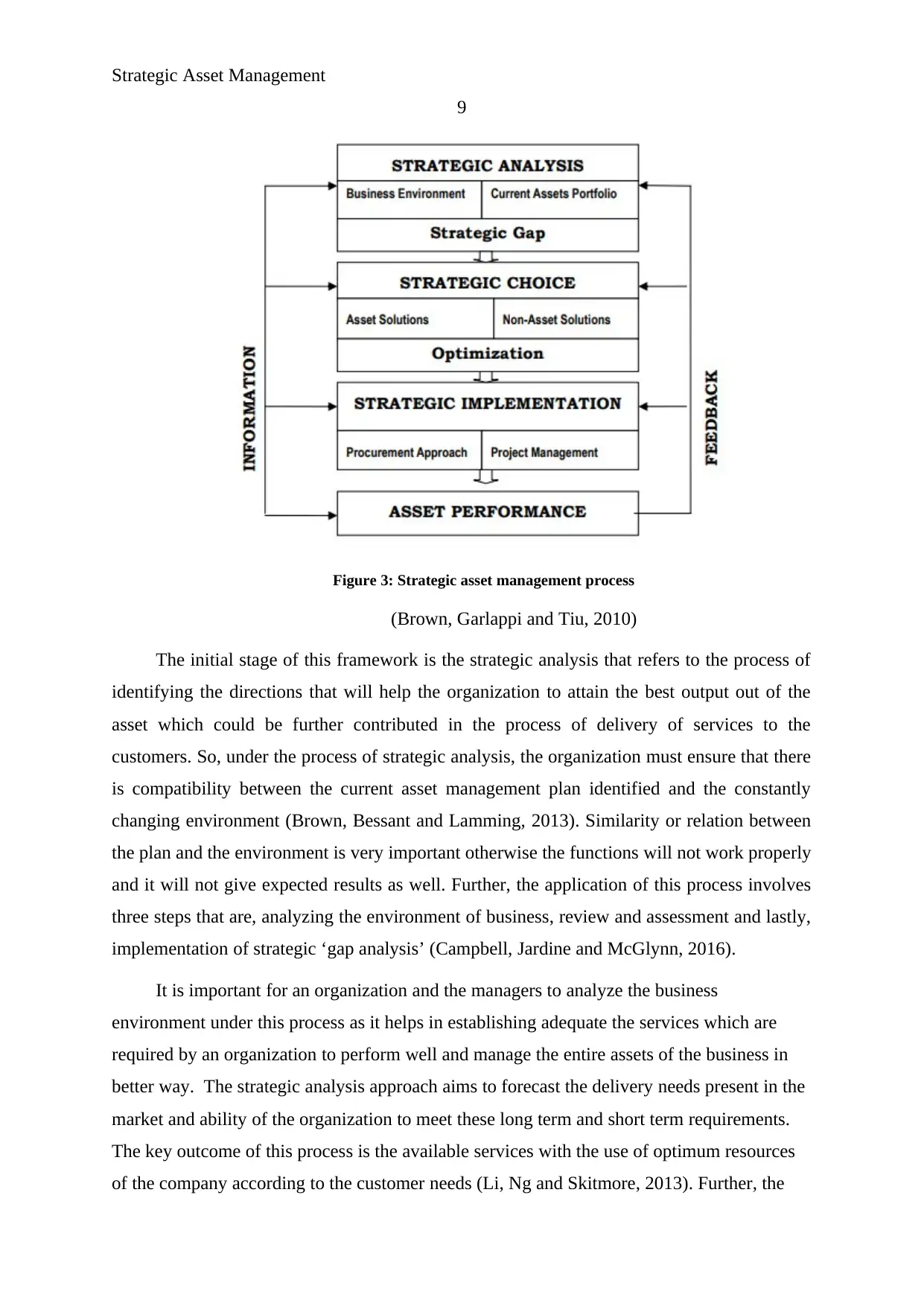
Strategic Asset Management
9
Figure 3: Strategic asset management process
(Brown, Garlappi and Tiu, 2010)
The initial stage of this framework is the strategic analysis that refers to the process of
identifying the directions that will help the organization to attain the best output out of the
asset which could be further contributed in the process of delivery of services to the
customers. So, under the process of strategic analysis, the organization must ensure that there
is compatibility between the current asset management plan identified and the constantly
changing environment (Brown, Bessant and Lamming, 2013). Similarity or relation between
the plan and the environment is very important otherwise the functions will not work properly
and it will not give expected results as well. Further, the application of this process involves
three steps that are, analyzing the environment of business, review and assessment and lastly,
implementation of strategic ‘gap analysis’ (Campbell, Jardine and McGlynn, 2016).
It is important for an organization and the managers to analyze the business
environment under this process as it helps in establishing adequate the services which are
required by an organization to perform well and manage the entire assets of the business in
better way. The strategic analysis approach aims to forecast the delivery needs present in the
market and ability of the organization to meet these long term and short term requirements.
The key outcome of this process is the available services with the use of optimum resources
of the company according to the customer needs (Li, Ng and Skitmore, 2013). Further, the
9
Figure 3: Strategic asset management process
(Brown, Garlappi and Tiu, 2010)
The initial stage of this framework is the strategic analysis that refers to the process of
identifying the directions that will help the organization to attain the best output out of the
asset which could be further contributed in the process of delivery of services to the
customers. So, under the process of strategic analysis, the organization must ensure that there
is compatibility between the current asset management plan identified and the constantly
changing environment (Brown, Bessant and Lamming, 2013). Similarity or relation between
the plan and the environment is very important otherwise the functions will not work properly
and it will not give expected results as well. Further, the application of this process involves
three steps that are, analyzing the environment of business, review and assessment and lastly,
implementation of strategic ‘gap analysis’ (Campbell, Jardine and McGlynn, 2016).
It is important for an organization and the managers to analyze the business
environment under this process as it helps in establishing adequate the services which are
required by an organization to perform well and manage the entire assets of the business in
better way. The strategic analysis approach aims to forecast the delivery needs present in the
market and ability of the organization to meet these long term and short term requirements.
The key outcome of this process is the available services with the use of optimum resources
of the company according to the customer needs (Li, Ng and Skitmore, 2013). Further, the
⊘ This is a preview!⊘
Do you want full access?
Subscribe today to unlock all pages.

Trusted by 1+ million students worldwide
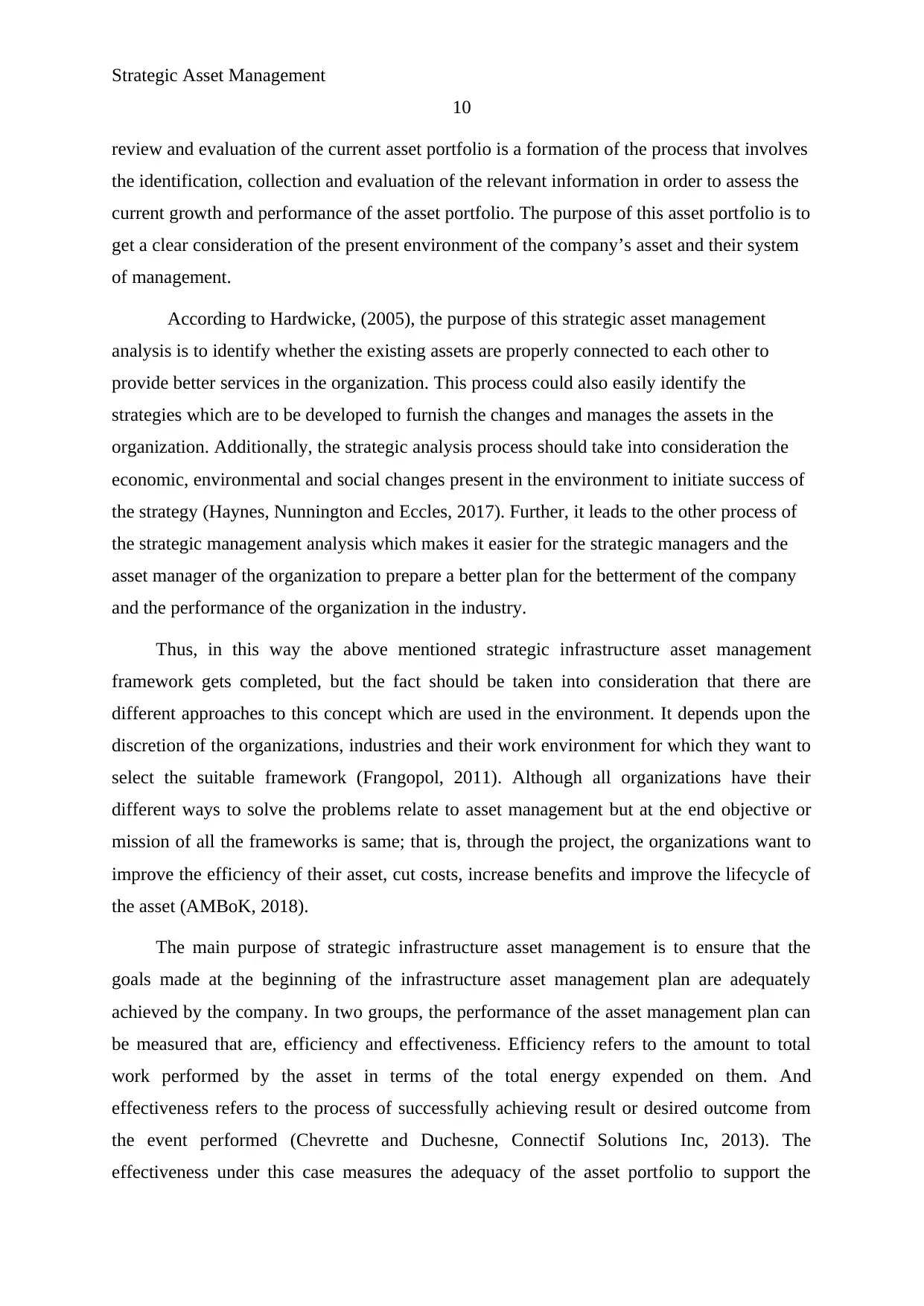
Strategic Asset Management
10
review and evaluation of the current asset portfolio is a formation of the process that involves
the identification, collection and evaluation of the relevant information in order to assess the
current growth and performance of the asset portfolio. The purpose of this asset portfolio is to
get a clear consideration of the present environment of the company’s asset and their system
of management.
According to Hardwicke, (2005), the purpose of this strategic asset management
analysis is to identify whether the existing assets are properly connected to each other to
provide better services in the organization. This process could also easily identify the
strategies which are to be developed to furnish the changes and manages the assets in the
organization. Additionally, the strategic analysis process should take into consideration the
economic, environmental and social changes present in the environment to initiate success of
the strategy (Haynes, Nunnington and Eccles, 2017). Further, it leads to the other process of
the strategic management analysis which makes it easier for the strategic managers and the
asset manager of the organization to prepare a better plan for the betterment of the company
and the performance of the organization in the industry.
Thus, in this way the above mentioned strategic infrastructure asset management
framework gets completed, but the fact should be taken into consideration that there are
different approaches to this concept which are used in the environment. It depends upon the
discretion of the organizations, industries and their work environment for which they want to
select the suitable framework (Frangopol, 2011). Although all organizations have their
different ways to solve the problems relate to asset management but at the end objective or
mission of all the frameworks is same; that is, through the project, the organizations want to
improve the efficiency of their asset, cut costs, increase benefits and improve the lifecycle of
the asset (AMBoK, 2018).
The main purpose of strategic infrastructure asset management is to ensure that the
goals made at the beginning of the infrastructure asset management plan are adequately
achieved by the company. In two groups, the performance of the asset management plan can
be measured that are, efficiency and effectiveness. Efficiency refers to the amount to total
work performed by the asset in terms of the total energy expended on them. And
effectiveness refers to the process of successfully achieving result or desired outcome from
the event performed (Chevrette and Duchesne, Connectif Solutions Inc, 2013). The
effectiveness under this case measures the adequacy of the asset portfolio to support the
10
review and evaluation of the current asset portfolio is a formation of the process that involves
the identification, collection and evaluation of the relevant information in order to assess the
current growth and performance of the asset portfolio. The purpose of this asset portfolio is to
get a clear consideration of the present environment of the company’s asset and their system
of management.
According to Hardwicke, (2005), the purpose of this strategic asset management
analysis is to identify whether the existing assets are properly connected to each other to
provide better services in the organization. This process could also easily identify the
strategies which are to be developed to furnish the changes and manages the assets in the
organization. Additionally, the strategic analysis process should take into consideration the
economic, environmental and social changes present in the environment to initiate success of
the strategy (Haynes, Nunnington and Eccles, 2017). Further, it leads to the other process of
the strategic management analysis which makes it easier for the strategic managers and the
asset manager of the organization to prepare a better plan for the betterment of the company
and the performance of the organization in the industry.
Thus, in this way the above mentioned strategic infrastructure asset management
framework gets completed, but the fact should be taken into consideration that there are
different approaches to this concept which are used in the environment. It depends upon the
discretion of the organizations, industries and their work environment for which they want to
select the suitable framework (Frangopol, 2011). Although all organizations have their
different ways to solve the problems relate to asset management but at the end objective or
mission of all the frameworks is same; that is, through the project, the organizations want to
improve the efficiency of their asset, cut costs, increase benefits and improve the lifecycle of
the asset (AMBoK, 2018).
The main purpose of strategic infrastructure asset management is to ensure that the
goals made at the beginning of the infrastructure asset management plan are adequately
achieved by the company. In two groups, the performance of the asset management plan can
be measured that are, efficiency and effectiveness. Efficiency refers to the amount to total
work performed by the asset in terms of the total energy expended on them. And
effectiveness refers to the process of successfully achieving result or desired outcome from
the event performed (Chevrette and Duchesne, Connectif Solutions Inc, 2013). The
effectiveness under this case measures the adequacy of the asset portfolio to support the
Paraphrase This Document
Need a fresh take? Get an instant paraphrase of this document with our AI Paraphraser
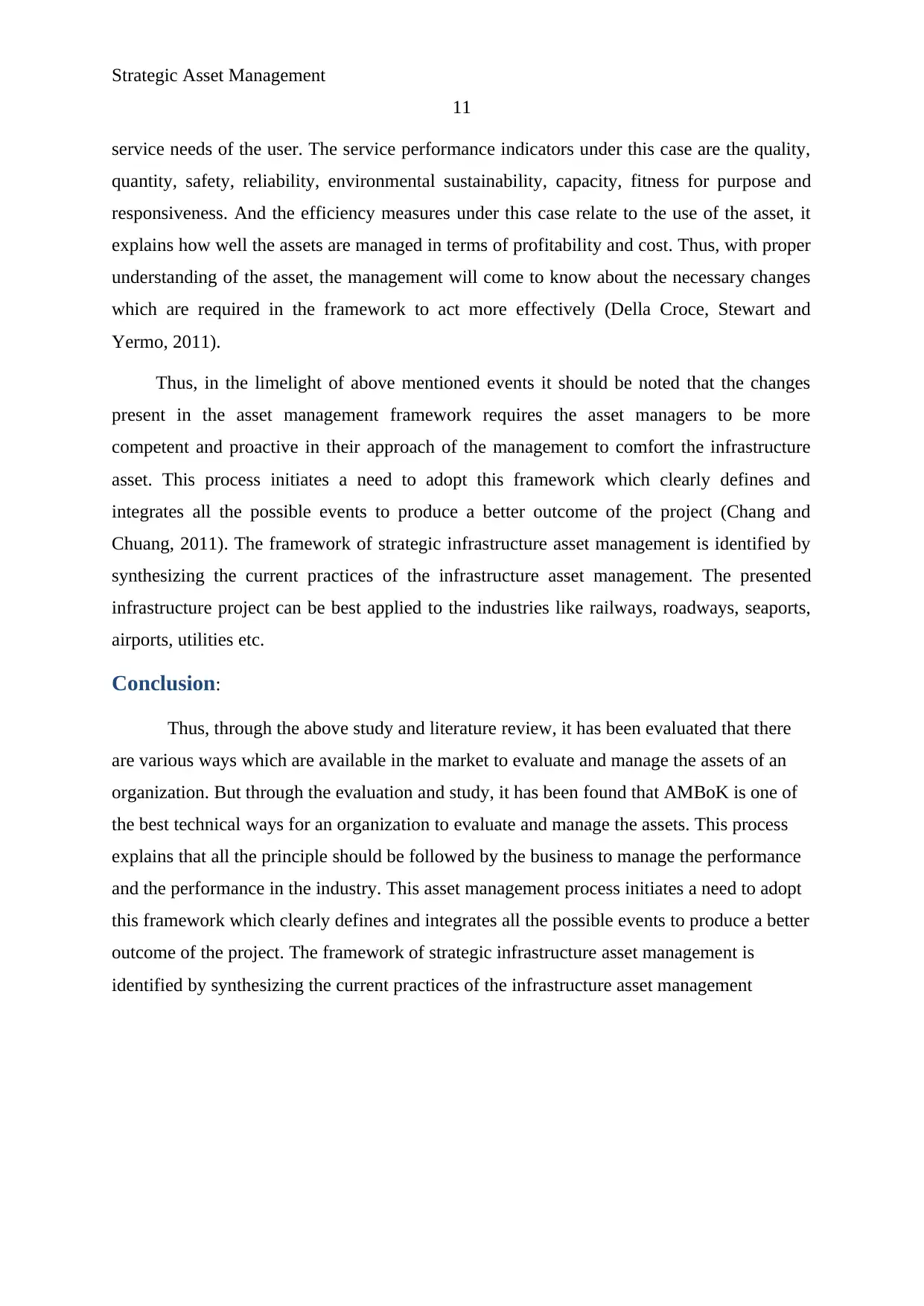
Strategic Asset Management
11
service needs of the user. The service performance indicators under this case are the quality,
quantity, safety, reliability, environmental sustainability, capacity, fitness for purpose and
responsiveness. And the efficiency measures under this case relate to the use of the asset, it
explains how well the assets are managed in terms of profitability and cost. Thus, with proper
understanding of the asset, the management will come to know about the necessary changes
which are required in the framework to act more effectively (Della Croce, Stewart and
Yermo, 2011).
Thus, in the limelight of above mentioned events it should be noted that the changes
present in the asset management framework requires the asset managers to be more
competent and proactive in their approach of the management to comfort the infrastructure
asset. This process initiates a need to adopt this framework which clearly defines and
integrates all the possible events to produce a better outcome of the project (Chang and
Chuang, 2011). The framework of strategic infrastructure asset management is identified by
synthesizing the current practices of the infrastructure asset management. The presented
infrastructure project can be best applied to the industries like railways, roadways, seaports,
airports, utilities etc.
Conclusion:
Thus, through the above study and literature review, it has been evaluated that there
are various ways which are available in the market to evaluate and manage the assets of an
organization. But through the evaluation and study, it has been found that AMBoK is one of
the best technical ways for an organization to evaluate and manage the assets. This process
explains that all the principle should be followed by the business to manage the performance
and the performance in the industry. This asset management process initiates a need to adopt
this framework which clearly defines and integrates all the possible events to produce a better
outcome of the project. The framework of strategic infrastructure asset management is
identified by synthesizing the current practices of the infrastructure asset management
11
service needs of the user. The service performance indicators under this case are the quality,
quantity, safety, reliability, environmental sustainability, capacity, fitness for purpose and
responsiveness. And the efficiency measures under this case relate to the use of the asset, it
explains how well the assets are managed in terms of profitability and cost. Thus, with proper
understanding of the asset, the management will come to know about the necessary changes
which are required in the framework to act more effectively (Della Croce, Stewart and
Yermo, 2011).
Thus, in the limelight of above mentioned events it should be noted that the changes
present in the asset management framework requires the asset managers to be more
competent and proactive in their approach of the management to comfort the infrastructure
asset. This process initiates a need to adopt this framework which clearly defines and
integrates all the possible events to produce a better outcome of the project (Chang and
Chuang, 2011). The framework of strategic infrastructure asset management is identified by
synthesizing the current practices of the infrastructure asset management. The presented
infrastructure project can be best applied to the industries like railways, roadways, seaports,
airports, utilities etc.
Conclusion:
Thus, through the above study and literature review, it has been evaluated that there
are various ways which are available in the market to evaluate and manage the assets of an
organization. But through the evaluation and study, it has been found that AMBoK is one of
the best technical ways for an organization to evaluate and manage the assets. This process
explains that all the principle should be followed by the business to manage the performance
and the performance in the industry. This asset management process initiates a need to adopt
this framework which clearly defines and integrates all the possible events to produce a better
outcome of the project. The framework of strategic infrastructure asset management is
identified by synthesizing the current practices of the infrastructure asset management
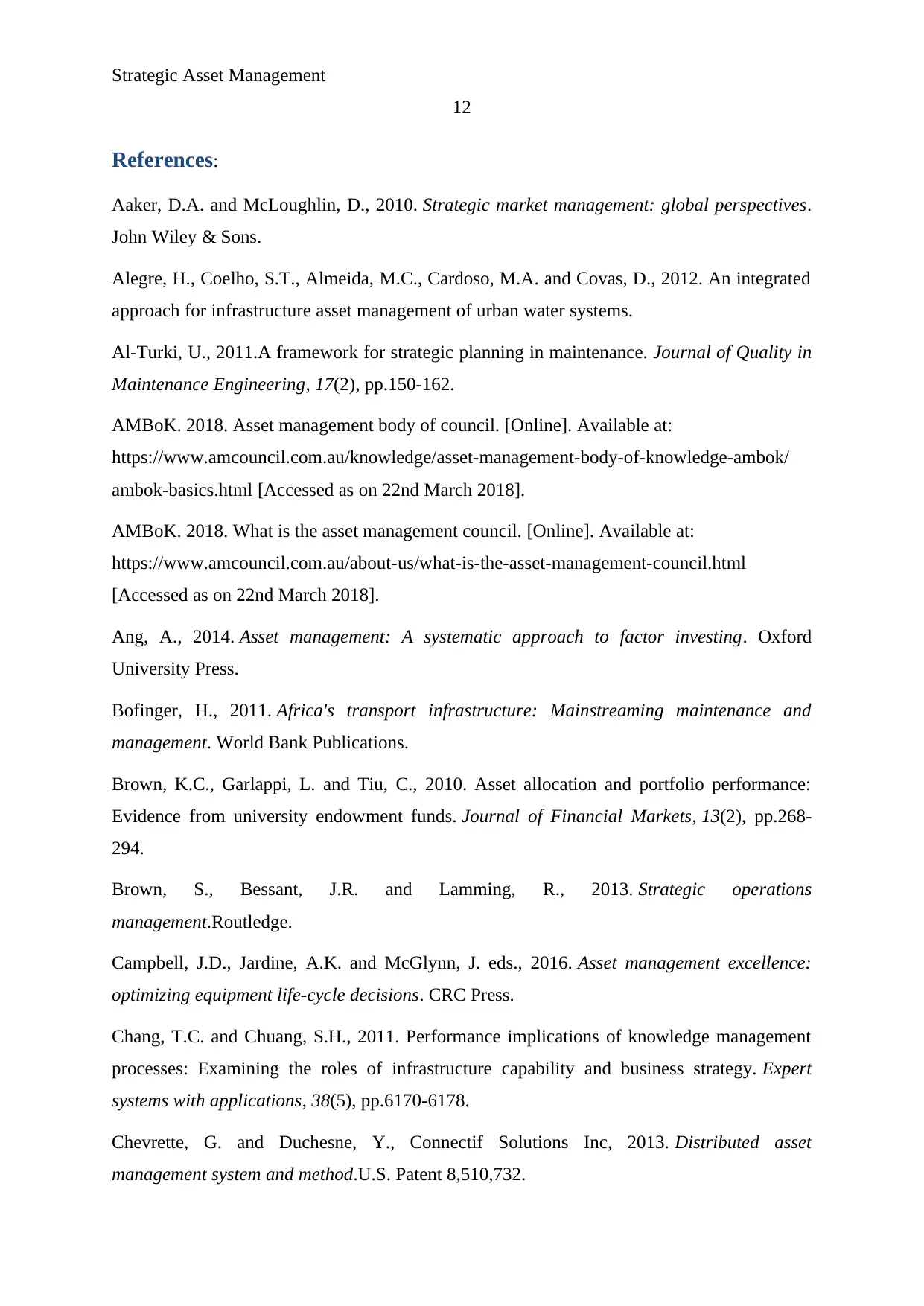
Strategic Asset Management
12
References:
Aaker, D.A. and McLoughlin, D., 2010. Strategic market management: global perspectives.
John Wiley & Sons.
Alegre, H., Coelho, S.T., Almeida, M.C., Cardoso, M.A. and Covas, D., 2012. An integrated
approach for infrastructure asset management of urban water systems.
Al-Turki, U., 2011.A framework for strategic planning in maintenance. Journal of Quality in
Maintenance Engineering, 17(2), pp.150-162.
AMBoK. 2018. Asset management body of council. [Online]. Available at:
https://www.amcouncil.com.au/knowledge/asset-management-body-of-knowledge-ambok/
ambok-basics.html [Accessed as on 22nd March 2018].
AMBoK. 2018. What is the asset management council. [Online]. Available at:
https://www.amcouncil.com.au/about-us/what-is-the-asset-management-council.html
[Accessed as on 22nd March 2018].
Ang, A., 2014. Asset management: A systematic approach to factor investing. Oxford
University Press.
Bofinger, H., 2011. Africa's transport infrastructure: Mainstreaming maintenance and
management. World Bank Publications.
Brown, K.C., Garlappi, L. and Tiu, C., 2010. Asset allocation and portfolio performance:
Evidence from university endowment funds. Journal of Financial Markets, 13(2), pp.268-
294.
Brown, S., Bessant, J.R. and Lamming, R., 2013. Strategic operations
management.Routledge.
Campbell, J.D., Jardine, A.K. and McGlynn, J. eds., 2016. Asset management excellence:
optimizing equipment life-cycle decisions. CRC Press.
Chang, T.C. and Chuang, S.H., 2011. Performance implications of knowledge management
processes: Examining the roles of infrastructure capability and business strategy. Expert
systems with applications, 38(5), pp.6170-6178.
Chevrette, G. and Duchesne, Y., Connectif Solutions Inc, 2013. Distributed asset
management system and method.U.S. Patent 8,510,732.
12
References:
Aaker, D.A. and McLoughlin, D., 2010. Strategic market management: global perspectives.
John Wiley & Sons.
Alegre, H., Coelho, S.T., Almeida, M.C., Cardoso, M.A. and Covas, D., 2012. An integrated
approach for infrastructure asset management of urban water systems.
Al-Turki, U., 2011.A framework for strategic planning in maintenance. Journal of Quality in
Maintenance Engineering, 17(2), pp.150-162.
AMBoK. 2018. Asset management body of council. [Online]. Available at:
https://www.amcouncil.com.au/knowledge/asset-management-body-of-knowledge-ambok/
ambok-basics.html [Accessed as on 22nd March 2018].
AMBoK. 2018. What is the asset management council. [Online]. Available at:
https://www.amcouncil.com.au/about-us/what-is-the-asset-management-council.html
[Accessed as on 22nd March 2018].
Ang, A., 2014. Asset management: A systematic approach to factor investing. Oxford
University Press.
Bofinger, H., 2011. Africa's transport infrastructure: Mainstreaming maintenance and
management. World Bank Publications.
Brown, K.C., Garlappi, L. and Tiu, C., 2010. Asset allocation and portfolio performance:
Evidence from university endowment funds. Journal of Financial Markets, 13(2), pp.268-
294.
Brown, S., Bessant, J.R. and Lamming, R., 2013. Strategic operations
management.Routledge.
Campbell, J.D., Jardine, A.K. and McGlynn, J. eds., 2016. Asset management excellence:
optimizing equipment life-cycle decisions. CRC Press.
Chang, T.C. and Chuang, S.H., 2011. Performance implications of knowledge management
processes: Examining the roles of infrastructure capability and business strategy. Expert
systems with applications, 38(5), pp.6170-6178.
Chevrette, G. and Duchesne, Y., Connectif Solutions Inc, 2013. Distributed asset
management system and method.U.S. Patent 8,510,732.
⊘ This is a preview!⊘
Do you want full access?
Subscribe today to unlock all pages.

Trusted by 1+ million students worldwide
1 out of 15
Related Documents
Your All-in-One AI-Powered Toolkit for Academic Success.
+13062052269
info@desklib.com
Available 24*7 on WhatsApp / Email
![[object Object]](/_next/static/media/star-bottom.7253800d.svg)
Unlock your academic potential
Copyright © 2020–2025 A2Z Services. All Rights Reserved. Developed and managed by ZUCOL.



